
Fountain of the Great Lakes, or Spirit of the Great Lakes Fountain, is an allegorical sculpture and fountain by Lorado Taft. The bronze artwork, created between 1907 and 1913, depicts five women arranged so that the fountains waterfall recalls the waterflow through the five Great Lakes of North America. In the Great Lakes, the waterflow begins in Lake Superior at 600 feet (180 m) above sea level and continues eastward through each lake until it reaches Lake Ontario. The Fountain is one of Taft's best known works. It is located in the public South McCormick Memorial Court of the Art Institute of Chicago, in the Chicago Loop.

Richard Henry Park was an American sculptor who worked in marble and bronze. He was commissioned to do work by the wealthy of the nineteenth century. He did a marble bust of John Plankinton, an astute businessman who founded the meat industry in Wisconsin and was "Milwaukee's foremost citizen."
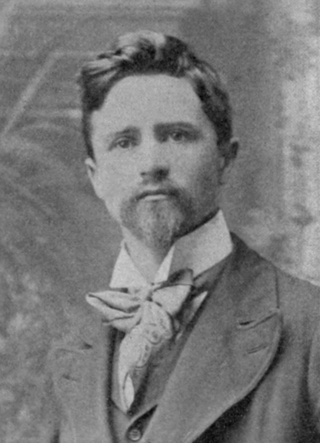
Sigvald Asbjørnsen was a Norwegian-born American sculptor.

The Victorious Charge is a public artwork by American artist John S. Conway located on the Court of Honor on West Wisconsin Avenue in downtown Milwaukee, Wisconsin, United States. The 1898 bronze sculpture is 9'10" high and sits on a 20' square granite pedestal.
Henry Bergh is a statue by American artist James H. Mahoney located at the Wisconsin Humane Society in Milwaukee, Wisconsin, United States. The bronze statue portrays Henry Bergh, the father of the humane movement in the United States, holding a cane in his proper right hand and petting a dog with a bandaged paw with his proper left hand. It was created in 1891 and stands 9 feet high.

Spirit of Commerce is a public artwork by German artist Gustav Haug located in Jackson Park, which is on the south side of Milwaukee, Wisconsin. This zinc sculpture is 15 feet tall and sits on a red granite pedestal near the park's lagoon. It is the oldest public sculpture in Milwaukee.
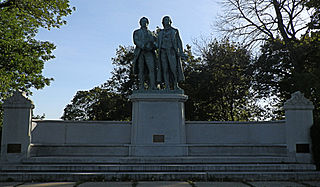
The Goethe–Schiller Monument is a public artwork by German artist Ernst Friedrich August Rietschel located in Washington Park, which is in Milwaukee, Wisconsin, United States. The bronze sculpture from 1908 depicts two men, Johann Wolfgang von Goethe and Friedrich von Schiller, one holding a laurel wreath and the other a scroll. The 12 foot artwork rests upon a 26 foot long granite base. The bronze sculpture is a recasting of the statue incorporated into the 1857 Goethe-Schiller Monument in Weimar, Germany.
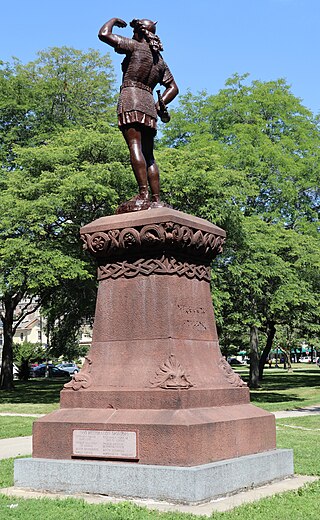
Leif, the Discoverer is a bronze sculpture of Leif Ericson created by American sculptor Anne Whitney in 1887. It is located at Juneau Park in Milwaukee, Wisconsin, United States.

The Letter Carriers' Monument is a piece of public art by American artist Elliot Offner, located on a triangular plot formed by North 2nd Street, North Plankinton Avenue and West Wells Street in downtown Milwaukee, Wisconsin, in the United States. Created in 1989, the monument depicts three letter carriers and was commissioned in celebration of the centennial of the National Association of Letter Carriers (NALC).
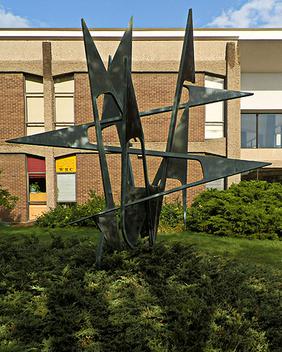
Polyphony is a public artwork by Austrian artist Egon Weiner located on the University of Wisconsin–Milwaukee campus, which is in Milwaukee, Wisconsin, United States.

Eight Stone Lions is a set of Bedford limestone or sandstone sculptures by Paul Kupper (?-1908) located in Lake Park in Milwaukee, Wisconsin, United States.

A statue of Abraham Lincoln by American artist Gaetano Cecere is installed along Lincoln Memorial Drive in Milwaukee, Wisconsin, United States. The 10'6" bronze sculpture depicts a young beardless Abraham Lincoln. The former president stands looking down with both hands at his sides.

The Washington Monument is a public artwork by American artist Richard Henry Park located on the Court of Honor in front of the Milwaukee Public Library Central Library, which is near Marquette University in Milwaukee, Wisconsin. The bronze sculpture is a full-length portrait of a 43-year-old George Washington, and stands on a granite pedestal; a bronze woman points up at Washington while a child, also made out of bronze, gazes upward. It was sculpted by Richard Henry Park and was erected in 1885 with philanthropic financial support from Elizabeth Plankinton. The statue was restored between July 2016 and January 2018.

Immigrant Mother is a public artwork by Croatian artist Ivan Meštrović located in Cathedral Square Park in Milwaukee, Wisconsin, United States. The bronze sculpture sits on a red granite base and depicts a mother with her children.

The Lapham Memorial is a public artwork by American artist Albert H. Atkins, located near the entrance to Lapham Hall, on the University of Wisconsin–Milwaukee campus. It is in memory of Increase A. Lapham, a 19th-century scientist famous for prompting the creation of the National Weather Service and recording the antiquities of Wisconsin, among other accomplishments.

General Douglas MacArthur is a public artwork by American artist Robert L. Dean, a 1953 graduate of the United States Military Academy. Previously, the statue was located in MacArthur Square in the Milwaukee Civic Center Plaza, downtown Milwaukee, Wisconsin, USA. On June 7, 2014, it was relocated to its new waterfront location at Veterans' Park, next to the Milwaukee County War Memorial Center. With full military honors, the bronze statue of General Douglas MacArthur was rededicated at its new home on June 7, 2014. The ceremony was the capstone event for the MacArthur Memorial Week, held nearly 35 years after the statue's original dedication on June 8, 1979.
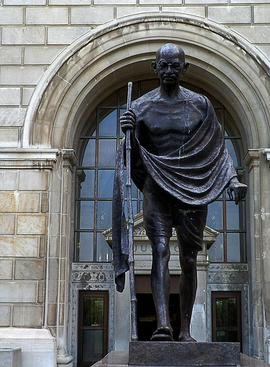
The Mahatma Gandhi Memorial is a 2002 public sculpture by Gautam Pal located at the Milwaukee County Courthouse in downtown Milwaukee, Wisconsin, United States.

The Harriet Tubman Memorial, also known as Step on Board, is located in Harriet Tubman Park in the South End neighborhood of Boston, Massachusetts. It honours the life of abolitionist Harriet Tubman. It was the first memorial erected in Boston to a woman on city-owned property.

Fern Cunningham was an American sculptor. One of her best known works is the Harriet Tubman Memorial, which was the first statue honoring a woman on city-owned land in Boston.

The Ulysses S. Grant Monument is a presidential memorial in Chicago, honoring American Civil War general and 18th President of the United States Ulysses S. Grant. Located in Lincoln Park, the statue was commissioned shortly after the president's death in 1885 and was completed in 1891. Several artists submitted sketches, and Louis Rebisso was selected to design the statue, with a granite pedestal suggested by William Le Baron Jenney. At the time of its completion, the monument was the largest bronze statue cast in the United States, and over 250,000 people were present at the dedication.


















